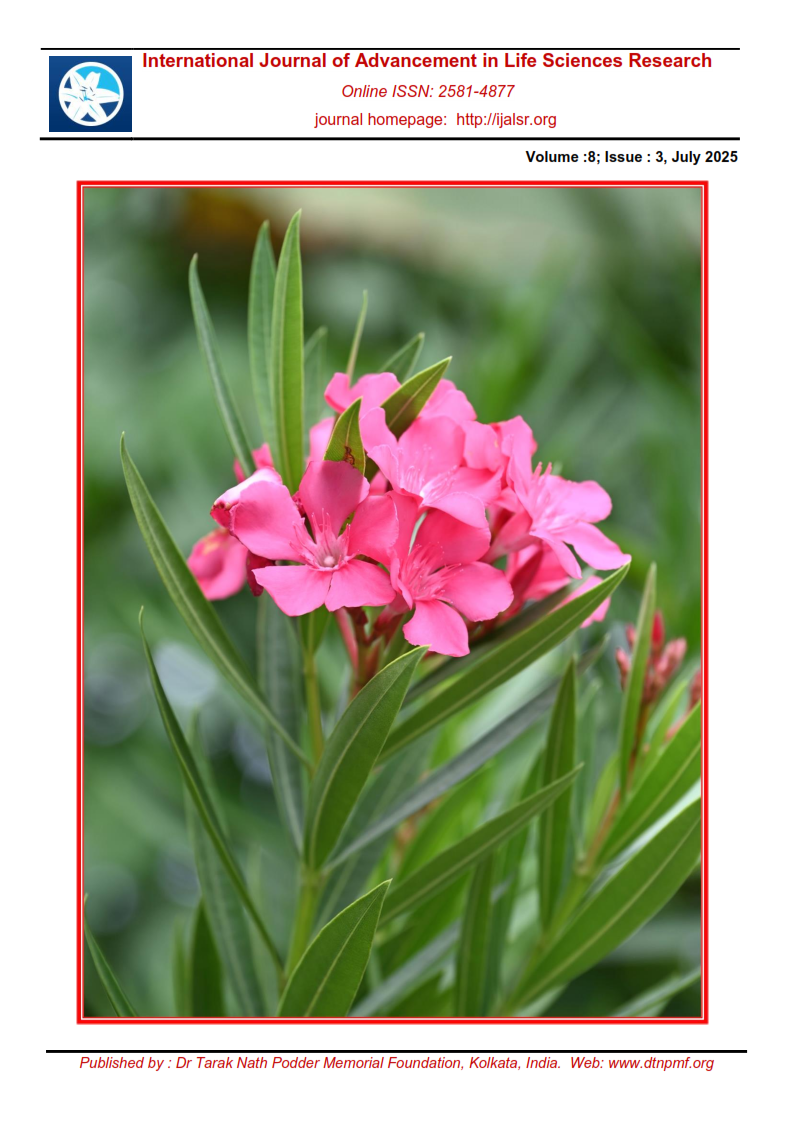Avifaunal Diversity of Patna Bird Sanctuary under the Taj Trapezium Zone in India
Abstract
The paper documents the avifaunal diversity of Patna Bird Sanctuary during a continuous survey period from March 2023 to February 2024. This sanctuary is a vital wetland component of the Taj Trapezium Zone (TTZ). A total of 127 bird species, comprising 19 orders and 47 families, were observed using the fixed radius point count method. The study emphasises the importance of continued monitoring to understand seasonal variations, population trends, and the conservation needs of avifauna in this region. These findings provide a valuable baseline for ongoing ecological sustainability and contribute to the quality of life in the wetlands of the Taj Trapezium Zone.
Downloads
References
Ali, S., Ripley, S. D., & Dick, J. H. (1987). Compact handbook of the birds of India and Pakistan: together with those of Bangladesh, Nepal, Bhutan and Sri Lanka (Second Edition). Oxford University Press, New York.
Bibby, C.J., D.A. Hill, N.D. Burgess & S. Mustoe (2000). Bird census techniques (2nd Edition). Academic Press, London, 302 pp.
BirdLife International (2024). Handbook of the Birds of the World and Bird Life International digital checklist of the birds of the world. Version 9. Accessed on 10th Mar 2025. https://datazone.birdlife.org/about-our-science/taxonomy
Donald, P. F., Fishpool, L. D., Ajagbe, A., Bennun, L. A., Bunting, G., Burfield, I. J., ... & Wege, D. C. (2019). Important Bird and Biodiversity Areas (IBAs): the development and characteristics of a global inventory of key sites for biodiversity. Bird Conservation International, 29(2), 177-198. http://dx.doi.org/10.1017/S0959270918000102
ebird (2025). eBird: An online database of bird distribution and abundance. eBird, Cornell Lab of Ornithology. Available at: http://www.ebird.org. Accessed on 16th May 2025.
Grimmett, R., C. Inskipp & T. Inskipp (2011). Birds of the Indian Subcontinent. Oxford University Press & Christopher Helm, London, 480 pp. Available at: https://www.amazon.in/Birds-Indian-Subcontinent-Carol-Inskipp/dp/019807722X
IUCN. (2024). The IUCN Red List of Threatened Species (Version 2024-1). https://www.iucnredlist.org . Accessed on 23rd March 2024.
Kingsford, R. T., Basset, A., & Jackson, L. (2016). Wetlands: conservation's poor cousins. Aquatic Conservation: Marine and Freshwater Ecosystems, 26(5), 892-916. https://doi.org/10.1002/AQC.2709
La Torre-Cuadros, M. D. L. Á., Herrando-Pérez, S., & Young, K. R. (2007). Diversity and structural patterns for tropical montane and premontane forests of central Peru, with an assessment of the use of higher-taxon surrogacy. Biodiversity and Conservation, 16, 2965-2988. https://doi.org/10.1007/s10531-007-9155-9
Ma, Z., Cai, Y., Li, B., & Chen, J. (2010). Managing wetland habitats for waterbirds: an international perspective. Wetlands, 30, 15-27. https://doi.org/10.1007/s13157-009-0001-6
Margalef, R. (1958). Temporal succession and spatial heterogeneity in phytoplankton (pp. 323–347). In A. A. Buzzati-Traverso (Ed.), Perspectives in marine biology (pp. 323–347). University of California Press, US. Available at: https://digital.csic.es/bitstream/10261/165671/3/Margelef_1958_preprint.pdf
Ministry of Environment, Forest and Climate Change. Wetlands of India Portal: National Wetlands Statistics. https://indianwetlands.in/wetlands-overview/national-wetlands-statistics/ Accessed on 17th May 2024.
Mitsch, W. J., & Gosselink, J. G. (1993). Wetlands (2nd ed.). Van Nostrand Reinhold. New York. https://doi.org/10.1002/ldr.3400050107
Pielou, E. C. (1966). The measurement of diversity in different types of biological collections. Journal of Theoretical Biology, 13, 131-144. https://doi.org/10.1016/0022-5193(66)90013-0
Praveen J., & Jayapal, R. (2024). Taxonomic updates to the checklists of the birds of India and the South Asian region—2025. Indian BIRDS 20 (6): 165–169. https://indianbirds.in/india/. Accessed on 15th May 2024.
Rahmani, A. R., & Islam, Z. (2004). Important bird areas in India: Priority sites for conservation. Bombay Natural History Society and BirdLife International. Availble at: https://portals.iucn.org/library/node/28011
Şekercioğlu, C. H. (2006). Ecological significance of bird populations. In J. del Hoyo, A. Elliott, & D. A. Christie (Eds.), Handbook of the birds of the world (Vol. 11, pp. 15–51). Lynx Edicions. Available at: https://www.academia.edu/15286073/Ecological_significance_of_bird_populations
Shannon, C. E., & Weaver, W. (1963). The mathematical theory of communication. University of Illinois Press, US. Available at: https://pure.mpg.de/rest/items/item_2383164_3/component/file_2383163/content
Simpson, E. H. (1949). Measurement of diversity. Nature, 163, 688. https://doi.org/10.1038/163688a0
Woodward, R. T., & Wui, Y. S. (2001). The economic value of wetland services: a meta-analysis. Ecological Economics, 37(2), 257-270. https://doi.org/10.1016/S0921-8009(00)00276-7
Xu, X., Xie, Y., Qi, K., Luo, Z., & Wang, X. (2018). Detecting the response of bird communities and biodiversity to habitat loss and fragmentation due to urbanization. Science of the Total Environment, 624, 1561-1576. https://doi.org/10.1016/j.scitotenv.2017.12.143
Yadav, H., & Prakash, S. (2021). Diversity of spiders (Araneae) in the flood plains of the Taj trapezium zone of Agra. Applied Ecology and Environmental Sciences, 9(2), 149-155. https://doi.org/10.12691/aees-9-2-5

This work is licensed under a Creative Commons Attribution-NonCommercial 4.0 International License.


















 .
.